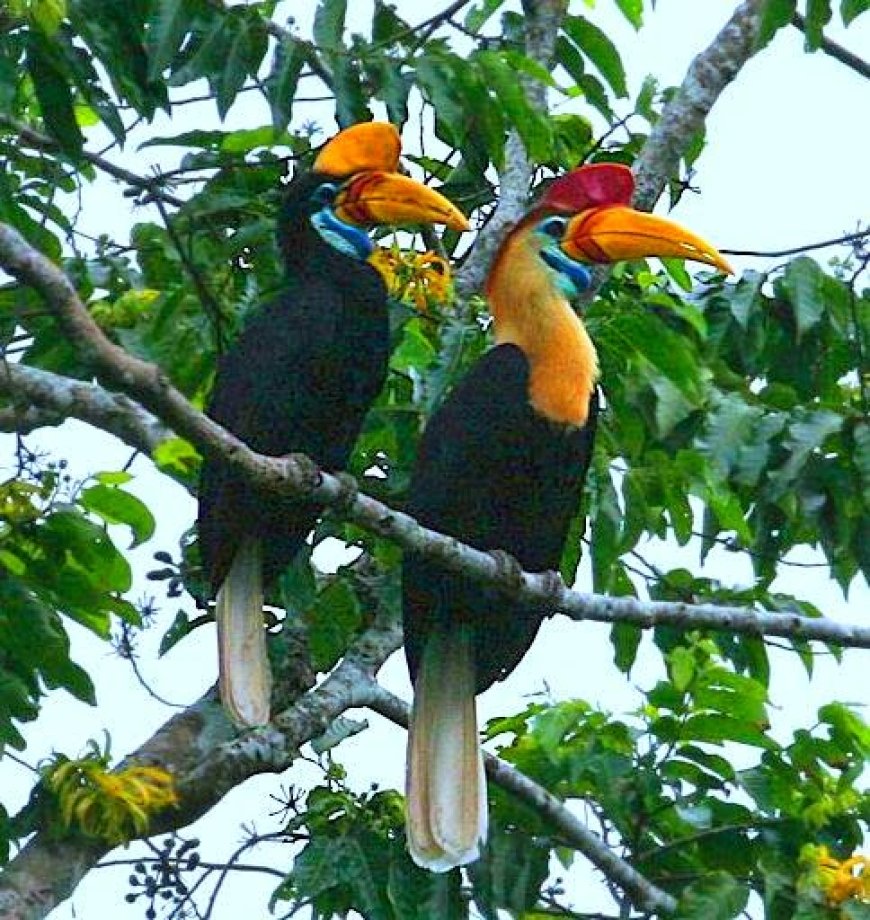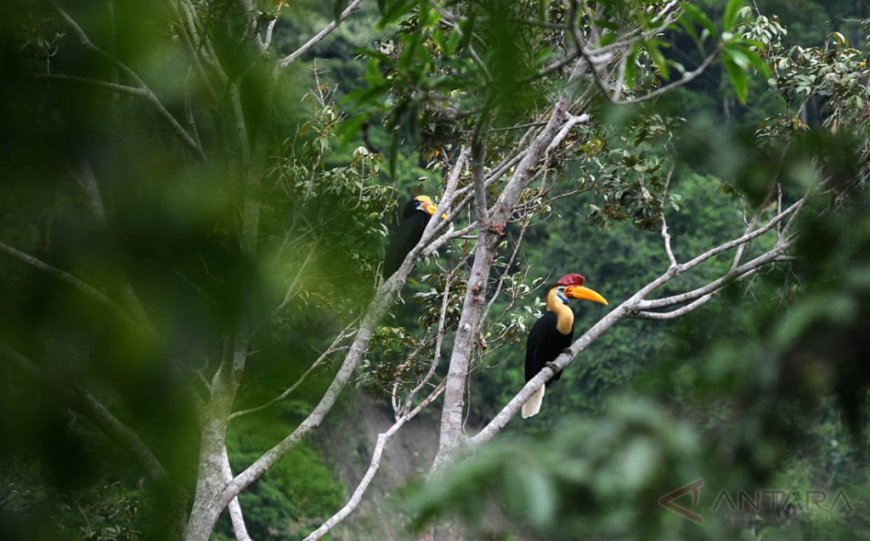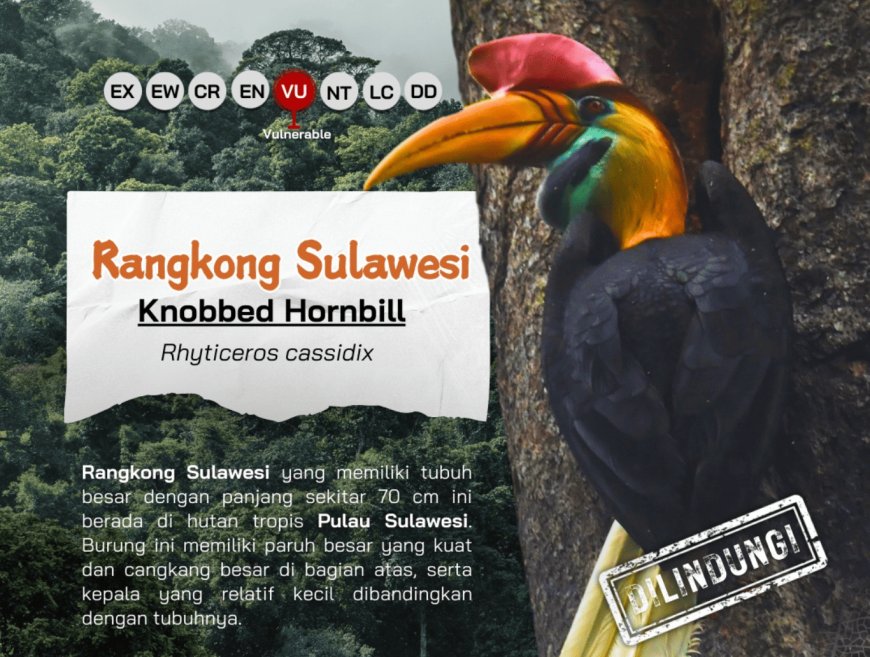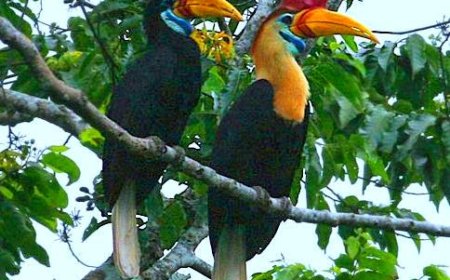Sulawesi Hornbill (Rhyticeros cassidix): Guardian of the Forest and Symbol of Loyalty in the Skies of Sulawesi
Discover the Sulawesi Hornbill (Rhyticeros cassidix), a stunning endemic bird of Sulawesi, known for its ecological role, lifelong loyalty, and critical conservation status.

Sulawesi Hornbill (Rhyticeros cassidix): Guardian of the Forest and Symbol
of Loyalty in the Skies of Sulawesi
Amid the lush tropical rainforests of Sulawesi, a deep, resonant wingbeat echoes through the trees. It signals the presence of one of the island’s most iconic avian species—the Sulawesi Hornbill, also known locally as Julang Sulawesi, scientifically named Rhyticeros cassidix. More than just a bird with a striking beak, the Sulawesi Hornbill is a symbol of ecological balance and lifelong loyalty in the wild.
🌍 Sulawesi Endemic: A Precious Natural Treasure
The Sulawesi Hornbill is found exclusively on Sulawesi Island and a few surrounding islets. It belongs to the Bucerotidae family—commonly referred to as hornbills. Its restricted distribution makes it a highly valuable endemic species.
For local communities, the Sulawesi Hornbill is more than just a forest dweller—it’s part of daily life and tradition. Across different areas, it is known by a variety of local names:
• “Alo” – In Bugis and Makassar languages, referring to large, loud forest birds.
• “Tando” – Used in parts of Luwu and Tana Toraja, describing big birds with a distinct “tok-tok” sound.
• “Burung Bertanduk” – Literally “horned bird,” referring to its prominent casque.
• “Tiong Buaya” – A name used in parts of Central Sulawesi, sometimes shared with other large hornbills.
Some Indigenous groups believe the bird’s loud call heralds the presence of ancestral spirits or changes in the season, adding a spiritual dimension to its presence.
🧬 Morphology: A Striking Physical Profile
The Sulawesi Hornbill’s appearance is as grand as its ecological role:
• Large body, reaching 100–120 cm in length
• Huge, downward-curved beak colored golden-yellow to reddish, crowned by a prominent casque, especially in males
• Bright red throat skin in males; bluish-purple in females
• Shiny black plumage with a contrasting white tail
• Reddish-brown iris in males; pale bluish-white in females
Its casque is not just decorative—it acts as a sound amplifier, allowing its calls to resonate through the dense forest canopy.
💡 Unique Behavior: Monogamous for Life
One of the most fascinating traits of the Sulawesi Hornbill is its lifelong monogamy. Pairs bond for life and exhibit remarkable nesting behavior during the breeding season:
• The female seals herself inside a tree cavity using mud, droppings, and fruit pulp, leaving only a small slit.
• The male feeds her and the chicks through the narrow opening—for weeks or even months.
• The female and young emerge only when the chick is ready to leave the nest.
This unique nesting strategy highlights a deep level of trust and cooperation between mates and the critical role males play in reproduction.

🌿 Ecological Role: Forest Farmer of the Skies
As a fruit-eater (frugivore), the Sulawesi Hornbill is a crucial seed disperser. By consuming various fleshy fruits and traveling long distances, it helps propagate native tree species throughout the forest—essential for natural reforestation and biodiversity.
⚠️ Threats and Conservation Status
Despite its importance, the Sulawesi Hornbill faces serious threats:
• Deforestation and habitat conversion
• Illegal hunting, especially for its decorative casque
• Wildlife trafficking due to its exotic appearance
• Habitat fragmentation, making it harder to find mates and nesting sites
It is currently listed as Vulnerable on the IUCN Red List and is legally protected under Indonesian law (Ministerial Regulation of Environment and Forestry No. P.106/MENLHK/SETJEN/KUM.1/12/2018).
🛡️ Conservation Efforts by BBKSDA Sulawesi Selatan
The South Sulawesi Natural Resources Conservation Agency (BBKSDA Sulsel) actively works to preserve the species through:
• Habitat protection within conservation areas such as Gandang Dewata National Park, Faruhumpenai Nature Reserve, and other managed forest zones
• Community education to stop hunting and promote wildlife protection
• Monitoring of nesting sites and populations
• Data-driven habitat modeling to inform science-based conservation policies

💬 What Can We Do?
• Do not buy, keep, or trade protected wildlife, including hornbills
• Support conservation initiatives and forest protection policies
• Educate others about the importance of biodiversity
• Report poaching or illegal wildlife trade to authorities
The Sulawesi Hornbill is not just a bird—it is a forest guardian, a symbol of devotion, and a natural conservationist. Protecting it means preserving the heart of Sulawesi’s rich ecosystem and cultural heritage.
Let’s protect the forest, safeguard hornbills, and nurture the future.
What's Your Reaction?
 Like
1
Like
1
 Dislike
0
Dislike
0
 Love
1
Love
1
 Funny
0
Funny
0
 Angry
0
Angry
0
 Sad
0
Sad
0
 Wow
1
Wow
1


